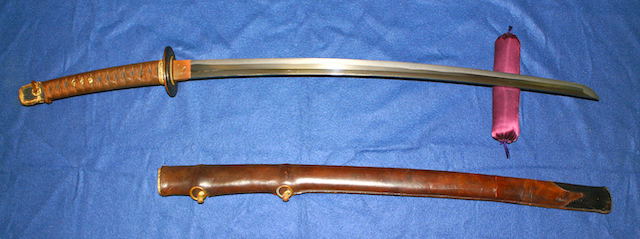During the Second World War, the most popular of all war souvenirs in the islands of the Pacific and occupied Japan was the “Samurai” sword.
Deeply imbedded in the psyche of the Japanese, the sword took on almost a sacred role. It was identified with the legendary Samurai warrior code of bushido. Not only did it hold a place of reverence in the ceremony and regalia of the Japanese imperial forces, but it was also designed to serve as an effective combat weapon.
By contrast, the U.S. military phased out the sword as a combat weapon around the time of the First World War, using it thereafter only for ceremonial purposes. This made the “Samurai” sword even more exotic and desirable to U.S. forces who encountered them in combat.
Many of these swords were family heirlooms, literally hundreds of years old and handed down from generation to generation. They were of superb quality, handmade from the finest materials, tempered and honed to a razor-sharp edge. Considered works of art, they were often “signed” by the master swordsmith who crafted the piece, many of whom became widely known and enjoyed a measure of celebrity due to the quality of their work. Not only functioning as a symbol of command, they were carried into and often used in battle by Japanese officers and senior enlisted men alike.
As the Japanese military expanded in the 1920s and 1930s, the demand for swords exceeded the supply and government arsenals stepped in to fill the void. Machine made and often of inferior quality, these mass-produced blades were issued to officers and NCOs to meet the increasing demand. One version, the Type 95 for use by non-commissioned officers, was even serial numbered.
Not considered a true “Samurai” sword and not as valuable as the older, handmade models, these were none-the-less eagerly sought by American servicemen, and counted among the thousands of swords brought back to the United States as souvenirs after World War II.
Pictured above is a long line of Japanese officers waiting to surrender their swords at the end of the war. Immediately below is an older blade signed by a master swordsmith. Below that is a mass-produced piece from the modern era, complete with leather combat cover to protect the “saya” or scabbard. All images are courtesy of Wikipedia. A Type 95 sword is part of the blades exhibit at the Italian American Veterans Museum.





0 comments on “Japanese blades of glory”